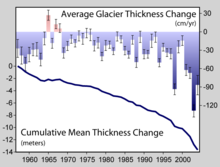Climate change or global warming is a serious threat to both animals and humanity (Lovejoy and Peters 24). The main causes are human activities that release more greenhouse gases, such as carbon dioxide into the atmosphere. In the coming years, the increase in the global temperatures will make many living populations less able to adapt to the emergent conditions or to migrate to other regions that are suitable for their survival. Living organisms depend on one another for survival and this makes ecosystems to be interdependent, including the functions of plants, animals, as well as microorganisms. Since concentration of carbon dioxide in the air has been on an upward trend (Figure 1), the existence of both humanity and animals has been seriously threatened.

Climate change has affected many regions, hence putting many living populations at risk of extinction. Drastic changes in weather patterns can cause detrimental effects on living species. One of the effects is the threat of extinction for many species because of isolation by geography, decreased population numbers, and a narrow temperature tolerance range. Climate change is a leading stressor on living populations. It may occur as a change in mean conditions or variance and frequency of the extremes of the climatic variables. As noted before, the changes may affect living populations directly or indirectly. In addition, the effects may be beneficial or negative through various impact mechanisms (Lovejoy and Peters 29). Living populations may be affected through the range, and abundant shifts, more over; they can be affected by changes in phenology. Changes may also occur in the physiology of the living populations as well as their behavior. There are evolutionary changes on the level of species response to climate change. Furthermore, living organisms may be affected at the ecosystem level, which may lead to structural changes, functional changes and patterns of balance and the increased dominance of alien or invasive species.
The existence of animals such as the polar bear has been threatened as global warming leads to the destruction of their habitat due to melting of the sea ice. This is because; increased temperatures lead to melting of glacier, resulting to rise in sea levels. Observable changes include a decline in the maximum extent of the sea ice. This happens in winter, which causes a decline of approximately 1.5% after every 10 years. According to studies, the changes in the sea ice occur at a faster rate, thus leading to loss of habitat. In addition, changes in the sea ice also affect the polar bears’ source of food by altering the prey species that they feed on. As a matter of concern, erratic weather patterns may alter eating habits of these animals since they are forced to compete with killer whales, which are classified as top-level predators. Moreover, climate change may cause some polar bears subpopulations to decline. Rabbits from several habitats face threats of rising sea levels, rising temperatures or reduction in snowfall. For instance, the snowshoe hare as well as the pygmy rabbit depend on snow for their protection during the winter season. However, because of reduction in snowfall in their habitations, their survival is at a great risk (Dowdeswell 44). Decrease in glacier level indicates less snow is precipitated to replace the additional melt (Fig 2).

Works Cited
Dowdeswell, H. William. Animal Ecology. New York: Taylor & Francis, 2007. Print.
Lovejoy, E., Thomas, and Peters L., Roberts. Global Warming and Biological Diversity. London: Yale University Press, 1992. Print.
Zemp, Michael. Global Glacier Changes: facts and figures. London: Cambridge University Press, 2010. Print.